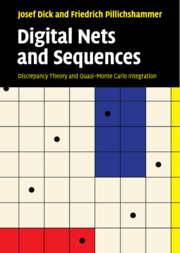Book contents
- Frontmatter
- Dedication
- Contents
- Preface
- Notation
- 1 Introduction
- 2 Quasi–Monte Carlo integration, discrepancy and reproducing kernel Hilbert spaces
- 3 Geometric discrepancy
- 4 Nets and sequences
- 5 Discrepancy estimates and average type results
- 6 Connections to other discrete objects
- 7 Duality theory
- 8 Special constructions of digital nets and sequences
- 9 Propagation rules for digital nets
- 10 Polynomial lattice point sets
- 11 Cyclic digital nets and hyperplane nets
- 12 Multivariate integration in weighted Sobolev spaces
- 13 Randomisation of digital nets
- 14 The decay of the Walsh coefficients of smooth functions
- 15 Arbitrarily high order of convergence of the worst-case error
- 16 Explicit constructions of point sets with the best possible order of L2-discrepancy
- Appendix A Walsh functions
- Appendix B Algebraic function fields
- References
- Index
Preface
Published online by Cambridge University Press: 05 July 2014
- Frontmatter
- Dedication
- Contents
- Preface
- Notation
- 1 Introduction
- 2 Quasi–Monte Carlo integration, discrepancy and reproducing kernel Hilbert spaces
- 3 Geometric discrepancy
- 4 Nets and sequences
- 5 Discrepancy estimates and average type results
- 6 Connections to other discrete objects
- 7 Duality theory
- 8 Special constructions of digital nets and sequences
- 9 Propagation rules for digital nets
- 10 Polynomial lattice point sets
- 11 Cyclic digital nets and hyperplane nets
- 12 Multivariate integration in weighted Sobolev spaces
- 13 Randomisation of digital nets
- 14 The decay of the Walsh coefficients of smooth functions
- 15 Arbitrarily high order of convergence of the worst-case error
- 16 Explicit constructions of point sets with the best possible order of L2-discrepancy
- Appendix A Walsh functions
- Appendix B Algebraic function fields
- References
- Index
Summary
The theory of digital nets and sequences has its roots in uniform distribution modulo one and in numerical integration using quasi–Monte Carlo (QMC) rules. The subject can be traced back to several influential works: the notion of uniform distribution to a classical paper by Weyl [265]; the Koksma–Hlawka inequality, which forms the starting point for analysing QMC methods for numerical integration, to Koksma [121] in the one-dimensional case and to Hlawka [111] in arbitrary dimension. Explicit constructions of digital sequences were first introduced by Sobol′ [253], followed by Faure [68] and Niederreiter [173]. A general principle of these constructions was introduced by Niederreiter in [172], which now forms one of the essential pillars of QMC integration and of this book. These early results are well summarised in references [61, 114, 130, 171 and 177], where much more information on the history and on earlier discoveries can be found.
Since then, numerical integration based on QMC has been developed into a comprehensive theory with many new facets. The introduction of reproducing kernel Hilbert spaces by Hickernell [101] furnished many Koksma–Hlawka-type inequalities. The worst-case integration error can be expressed directly in terms of a reproducing kernel, a function which, together with a uniquely defined inner product, describes a Hilbert space of functions.
Contrary to earlier suppositions, QMC methods are now used for the numerical integration of functions in hundreds or even thousands of dimensions. The success of this approach has been described by Sloan and Woźniakowski in [249], where the concept of weighted spaces was introduced.
Information
- Type
- Chapter
- Information
- Digital Nets and SequencesDiscrepancy Theory and Quasi–Monte Carlo Integration, pp. xi - xivPublisher: Cambridge University PressPrint publication year: 2010
